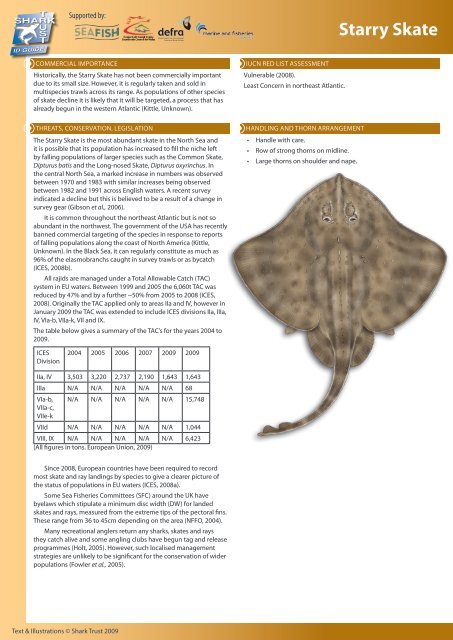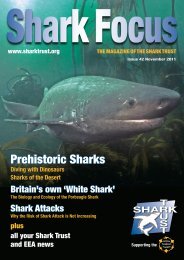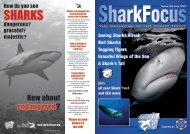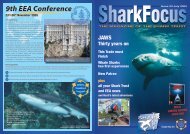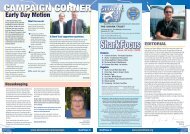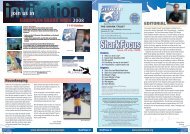Starry Skate Amblyraja radiata - The Shark Trust
Starry Skate Amblyraja radiata - The Shark Trust
Starry Skate Amblyraja radiata - The Shark Trust
You also want an ePaper? Increase the reach of your titles
YUMPU automatically turns print PDFs into web optimized ePapers that Google loves.
COMMERCIAL IMPORTANCE<br />
Historically, the <strong>Starry</strong> <strong>Skate</strong> has not been commercially important<br />
due to its small size. However, it is regularly taken and sold in<br />
multispecies trawls across its range. As populations of other species<br />
of skate decline it is likely that it will be targeted, a process that has<br />
already begun in the western Atlantic (Kittle, Unknown).<br />
THREATS, CONSERVATION, LEGISLATION<br />
<strong>The</strong> <strong>Starry</strong> <strong>Skate</strong> is the most abundant skate in the North Sea and<br />
it is possible that its population has increased to fill the niche left<br />
by falling populations of larger species such as the Common <strong>Skate</strong>,<br />
Dipturus batis and the Long-nosed <strong>Skate</strong>, Dipturus oxyrinchus. In<br />
the central North Sea, a marked increase in numbers was observed<br />
between 1970 and 1983 with similar increases being observed<br />
between 1982 and 1991 across English waters. A recent survey<br />
indicated a decline but this is believed to be a result of a change in<br />
survey gear (Gibson et al., 2006).<br />
It is common throughout the northeast Atlantic but is not so<br />
abundant in the northwest. <strong>The</strong> government of the USA has recently<br />
banned commercial targeting of the species in response to reports<br />
of falling populations along the coast of North America (Kittle,<br />
Unknown). In the Black Sea, it can regularly constitute as much as<br />
96% of the elasmobranchs caught in survey trawls or as bycatch<br />
(ICES, 2008b).<br />
All rajids are managed under a Total Allowable Catch (TAC)<br />
system in EU waters. Between 1999 and 2005 the 6,060t TAC was<br />
reduced by 47% and by a further ~50% from 2005 to 2008 (ICES,<br />
2008). Originally the TAC applied only to areas IIa and IV, however in<br />
January 2009 the TAC was extended to include ICES divisions IIa, IIIa,<br />
IV, VIa-b, VIIa-k, VII and IX.<br />
<strong>The</strong> table below gives a summary of the TAC’s for the years 2004 to<br />
2009.<br />
ICES<br />
Division<br />
2004 2005 2006 2007 2009 2009<br />
IIa, IV 3,503 3,220 2,737 2,190 1,643 1,643<br />
IIIa N/A N/A N/A N/A N/A 68<br />
VIa-b,<br />
VIIa-c,<br />
VIIe-k<br />
Supported by:<br />
N/A N/A N/A N/A N/A 15,748<br />
VIId N/A N/A N/A N/A N/A 1,044<br />
VIII, IX N/A N/A N/A N/A N/A 6,423<br />
(All figures in tons. European Union, 2009)<br />
Since 2008, European countries have been required to record<br />
most skate and ray landings by species to give a clearer picture of<br />
the status of populations in EU waters (ICES, 2008a).<br />
Some Sea Fisheries Committees (SFC) around the UK have<br />
byelaws which stipulate a minimum disc width (DW) for landed<br />
skates and rays, measured from the extreme tips of the pectoral fins.<br />
<strong>The</strong>se range from 36 to 45cm depending on the area (NFFO, 2004).<br />
Many recreational anglers return any sharks, skates and rays<br />
they catch alive and some angling clubs have begun tag and release<br />
programmes (Holt, 2005). However, such localised management<br />
strategies are unlikely to be significant for the conservation of wider<br />
populations (Fowler et al., 2005).<br />
Text & Illustrations © <strong>Shark</strong> <strong>Trust</strong> 2009<br />
IUCN RED LIST ASSESSMENT<br />
Vulnerable (2008).<br />
Least Concern in northeast Atlantic.<br />
HANDLING AND THORN ARRANGEMENT<br />
• Handle with care.<br />
• Row of strong thorns on midline.<br />
• Large thorns on shoulder and nape.<br />
<strong>Starry</strong> <strong>Skate</strong>


